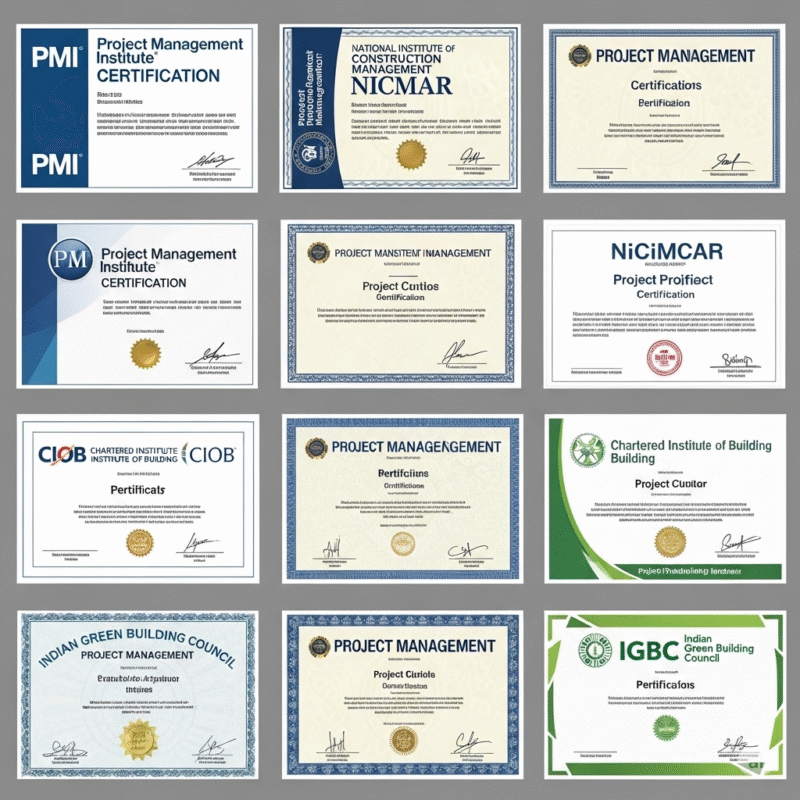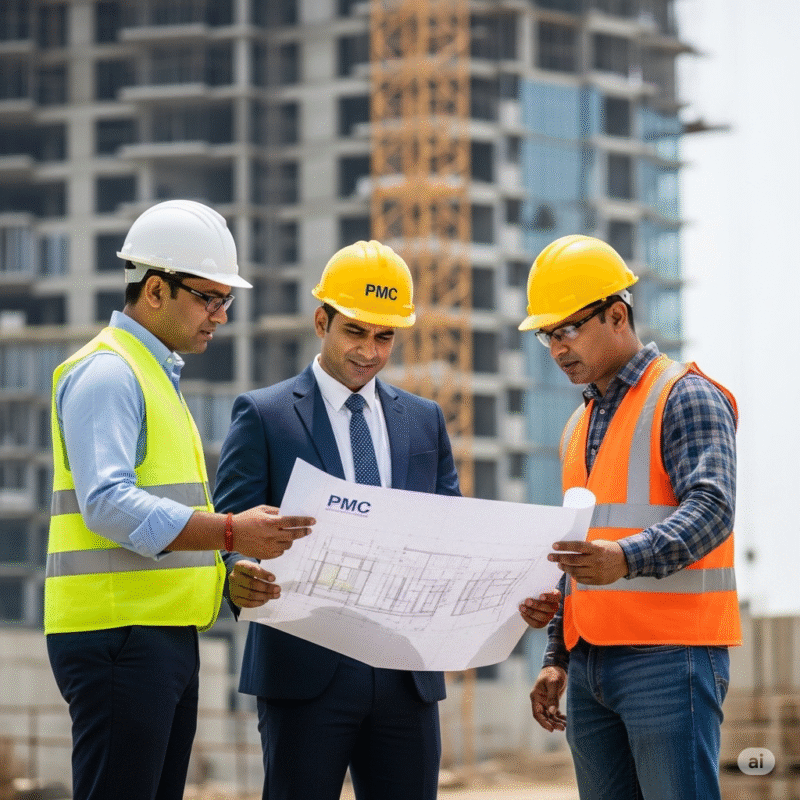Introduction
The journey from a bare plot of land to a fully constructed building involves a series of meticulously planned and executed steps. This blog post breaks down the civil works project lifecycle from excavation to superstructure, offering insights for professionals, developers, engineering enthusiasts, and individuals planning to build their own homes.
Whether you’re involved in residential projects (independent homes, group housing, or high-rises), commercial developments, or industrial constructions in India, understanding this critical phase of construction is essential for project success.

1. Site Preparation and Excavation
What is Site Preparation?
Site preparation involves making the construction site ready for building activities. This includes clearing, grubbing, demolition of existing structures (if any), and establishing site infrastructure.
Key Methodologies
Site Clearing and Grubbing
- Removal of vegetation, debris, and topsoil
- Setting up temporary facilities (site office, material storage, labor accommodation)
- Establishing utilities (temporary water, electricity)
Setting Out and Marking
- Transfer of design coordinates to the ground
- Marking building footprint and excavation boundaries
- Establishment of benchmark levels
Excavation Techniques
- Manual excavation (for small projects or detailed work)
- Mechanized excavation using backhoes, excavators, and loaders
- Blasting (for rocky terrain, requires special permissions)
Material and Manpower Requirements
| Resource Type | Requirements |
|---|---|
| Equipment | Excavators, backhoes, dump trucks, total station/theodolite, water pumps |
| Manpower | Site engineer, surveyor, equipment operators, unskilled laborers |
| Materials | Survey pegs, lime/chalk for marking, dewatering equipment |
Deliverables
- Site clearing report
- Survey and layout report
- Excavation plan and cross-sections
- Soil investigation report validation
Key Stakeholders and Communication
| Stakeholder | Role | Communication Channel |
|---|---|---|
| Project Manager | Overall responsibility | Weekly progress reports, daily site meetings |
| Site Engineer | Day-to-day supervision | Daily site reports, WhatsApp updates |
| Geotechnical Consultant | Soil testing and advice | Formal technical reports |
| Local Authorities | Permissions and compliance | Official correspondence |
| Client/Owner | Approval at key stages | Progress reports, milestone meetings |
Relevant Standards and Guidelines
- IS 1200 (Part 1): Method of measurement of building and civil engineering works – Earthwork
- IS 3764: Code of safety for excavation work
- IS 4081: Safety code for blasting and related drilling operations
- NBC 2016: National Building Code – Part 7 (Construction Management)
Value Engineering Opportunities
- Optimization of excavation depths based on soil bearing capacity
- Balancing cut and fill to minimize soil disposal costs
- Use of excavated material for backfilling or site development
- Planning excavation sequence to minimize equipment idle time
2. Foundation Works
What are Foundation Works?
Foundation works involve creating the substructure that transfers the building load safely to the ground. The choice of foundation type depends on soil conditions, building load, and site constraints.
Types of Foundations Commonly Used in India
Shallow Foundations
- Isolated footings
- Combined footings
- Raft/mat foundations
- Strip foundations
Deep Foundations
- Pile foundations (bored, driven, pre-cast)
- Well foundations
- Pier foundations
Key Methodologies
Foundation Bed Preparation
- Leveling of excavated surface
- Compaction of foundation bed
- Anti-termite treatment application
Reinforcement Work
- Bar bending and cutting as per structural drawings
- Assembly and placement of reinforcement cages
- Maintaining proper cover using spacers
Formwork Installation
- Erection of side shuttering for footings/raft
- Ensuring proper alignment and dimensions
- Applying release agents
Concrete Pouring and Curing
- Placement and compaction of concrete
- Surface finishing
- Curing for specified period (typically 7-14 days)
Material and Manpower Requirements
| Resource Type | Requirements |
|---|---|
| Equipment | Concrete mixers/RMC trucks, vibrators, pumps, shuttering materials |
| Manpower | Structural engineer, site supervisor, bar benders, shuttering carpenters, concrete workers |
| Materials | Cement, sand, aggregates, reinforcement steel, PVC pipes for sleeve insertion, curing compounds |
Deliverables
- Foundation layout plan verification report
- Bar bending schedule verification
- Concrete pour cards
- Quality control test reports (cube tests, slump tests)
- Foundation completion report
Key Stakeholders and Communication
| Stakeholder | Role | Communication Channel |
|---|---|---|
| Structural Engineer | Design and technical guidance | Technical queries, site visits |
| QA/QC Engineer | Quality control | Inspection requests, test reports |
| PMC/Client Representative | Approval at hold points | Joint inspections, approvals |
| Concrete Supplier | Material supply | Delivery schedules, mix design approvals |
Relevant Standards and Guidelines
- IS 456: Plain and Reinforced Concrete – Code of Practice
- IS 1786: High Strength Deformed Steel Bars for Concrete Reinforcement
- IS 2502: Code of Practice for Bending and Fixing of Bars for Concrete Reinforcement
- IS 10262: Guidelines for Concrete Mix Design
- IS 13920: Ductile Detailing of Reinforced Concrete Structures
Foundation Design Basis Calculation Example
For a simple isolated footing:
- Calculate total load (P) = Dead Load + Live Load + Wind/Seismic Load
- Determine Safe Bearing Capacity (SBC) of soil from soil test report
- Calculate required area of footing: A = P ÷ SBC
- Determine footing dimensions (L × B), typically square for isolated column footings
- Calculate depth based on punching shear: d = √(P ÷ (4 × τc × L))
Where:
- P = Total load in kN
- SBC = Safe bearing capacity in kN/m²
- A = Area in m²
- L, B = Length and breadth in m
- d = Effective depth in m
- τc = Permissible shear stress of concrete
Value Engineering Opportunities
- Optimizing foundation types based on soil conditions
- Using geotextiles to improve soil bearing capacity
- Considering ready-mix concrete vs. site-mixed concrete based on project size
- Alternative reinforcement methods like HYSD bars vs. TMT bars based on cost-benefit analysis
3. Plinth Beam and Columns (Up to Plinth Level)
What are Plinth Level Works?
Plinth level works connect the foundation to the superstructure and typically include the construction of columns up to plinth level and plinth beams that tie these columns together.
Key Methodologies
Setting Out and Marking
- Transferring column center lines from foundation
- Marking of plinth beam outlines
Column Construction
- Reinforcement cage assembly as per structural drawings
- Formwork erection and alignment
- Concrete pouring and curing
Plinth Beam Construction
- Reinforcement assembly and placement
- Formwork installation
- Concrete pouring and finishing
- Proper curing
Backfilling and Compaction
- Backfilling of excavated areas around foundations
- Layer-by-layer compaction to required density
- Anti-termite treatment of filled areas
Material and Manpower Requirements
| Resource Type | Requirements |
|---|---|
| Equipment | Concrete mixers, vibrators, compaction equipment, measuring tools |
| Manpower | Site engineer, formwork carpenters, bar benders, concrete workers, laborers |
| Materials | Cement, sand, aggregates, reinforcement steel, formwork materials, anti-termite chemicals |
Deliverables
- Plinth level marking verification report
- Column and plinth beam reinforcement inspection reports
- Concrete pour records
- Backfilling compaction test reports
- Plinth level completion certificate
Key Stakeholders and Communication
| Stakeholder | Role | Communication Channel |
|---|---|---|
| Construction Manager | Work coordination | Daily progress meetings |
| MEP Coordinator | Services coordination | Coordination drawings, site meetings |
| Architect | Design compliance | Site inspections, RFIs |
| Local Building Authority | Statutory inspection | Official notices, inspection reports |
Relevant Standards and Guidelines
- IS 456: Plain and Reinforced Concrete – Code of Practice
- IS 2212: Code of Practice for Brickwork
- IS 2645: Specification for Integral Waterproofing Compounds
- IS 6313: Anti-termite Measures in Buildings
Checklist for Plinth Level Works
- [ ] Column centers accurately marked as per drawing
- [ ] Reinforcement placement verified against structural drawings
- [ ] Cover blocks placed at specified intervals
- [ ] Formwork dimensions checked and approved
- [ ] Concrete mix design approved
- [ ] All service sleeves and inserts placed as per drawings
- [ ] Concrete pouring witnessed and recorded
- [ ] Curing arrangement adequate and maintained
- [ ] Backfilling done in layers with proper compaction
- [ ] Anti-termite treatment completed as specified
- [ ] Plinth level checked with instrument
Value Engineering Opportunities
- Using prefabricated reinforcement cages for repetitive columns
- Optimizing formwork reuse through proper planning
- Considering composite columns (concrete-filled steel tubes) for faster construction
- Using fly ash or GGBS as partial cement replacement for environmental and cost benefits
4. Superstructure – Columns, Beams, and Slabs
What is Superstructure Construction?
Superstructure works involve building the main framework of the structure above plinth level, including columns, beams, and floor slabs that form the skeleton of the building.
Key Methodologies
Column Construction
- Marking and transfer of column positions from lower floor
- Reinforcement cage assembly and placement
- Formwork erection and alignment
- Concrete pouring and curing
Beam and Slab Construction
- Erection of beam bottom and side shuttering
- Beam reinforcement placement
- Slab shuttering installation
- Slab reinforcement placement
- MEP services coordination (sleeves, conduits)
- Concrete pouring and finishing
- Curing management
Special Elements
- Staircases and landings
- Cantilever elements
- Double-height areas
Material and Manpower Requirements
| Resource Type | Requirements |
|---|---|
| Equipment | Tower crane/concrete pump, vibrators, screeding machines, scaffolding systems |
| Manpower | Structural engineer, site supervisors, formwork specialists, bar benders, concrete finishers |
| Materials | Cement, aggregates, sand, reinforcement steel, formwork systems, curing compounds |
Deliverables
- Pre-pour inspection reports
- Concrete pour cards
- Quality control test reports
- MEP services coordination sign-offs
- Floor-wise completion certificates
Key Stakeholders and Communication
| Stakeholder | Role | Communication Channel |
|---|---|---|
| Structural Consultant | Technical guidance | RFIs, site visits, technical clarifications |
| MEP Contractors | Services coordination | Coordination drawings, sleeves verification |
| PMC | Quality assurance | Inspection reports, NCRs if applicable |
| Safety Officer | Safety compliance | Safety audits, toolbox talks |
Relevant Standards and Guidelines
- IS 456: Plain and Reinforced Concrete – Code of Practice
- IS 875: Code of Practice for Design Loads
- IS 13920: Ductile Detailing of Reinforced Concrete Structures
- IS 14687: Falsework for Concrete Structures – Guidelines
- SP 34: Handbook on Concrete Reinforcement and Detailing
Flow Chart: Typical Superstructure Construction Sequence
Start → Column Marking → Column Reinforcement → Column Formwork →
Column Concrete → Column Curing → Beam Bottom Formwork →
Beam Reinforcement → Beam Side Formwork → Slab Bottom Formwork →
Slab Reinforcement → MEP Service Installation → Pre-pour Inspection →
Concrete Pouring → Finishing → Curing → Form Removal → Quality Check → Next Floor
Design Basis Example: Slab Design Consideration
Thickness Calculation:
- For residential buildings: h = L/24 (for simply supported)
- For office buildings: h = L/22 (for simply supported)
Where L is the effective span
Reinforcement Calculation (Simplified):
- Main reinforcement area = M / (σst × j × d)
- Distribution steel = 0.15% of gross concrete area
Where: - M = Bending moment
- σst = Permissible stress in steel
- j = Lever arm factor
- d = Effective depth
Value Engineering Opportunities
- Using aluminum formwork systems for repetitive floor layouts
- Pre-assembled reinforcement mats for slabs
- Self-compacting concrete for congested reinforcement areas
- Post-tensioned slabs for longer spans
- BIM coordination to reduce MEP conflicts and rework
5. Walls and Partitions
What are Wall and Partition Works?
Wall construction involves building the vertical dividing elements that separate interior spaces and form the external envelope of the building.
Key Methodologies
External Wall Construction
- Setting out and marking as per drawings
- Selection of appropriate materials (brick, block, or panels)
- Laying/installation with proper bonding patterns
- Integration with structural elements
Internal Partition Construction
- Lightweight systems (drywall, AAC blocks)
- Coordination with MEP services
- Acoustic considerations where required
Special Considerations
- Lintel and sill construction
- Wall openings for doors and windows
- Provision for electrical boxes and conduits
- Water-resistant treatments for wet areas
Material and Manpower Requirements
| Resource Type | Requirements |
|---|---|
| Equipment | Mortar mixers, scaffolding, masonry tools, cutting machines |
| Manpower | Masons, helpers, supervisors, services coordinators |
| Materials | Bricks/blocks, cement, sand, water, reinforcement for lintels, ties and anchors |
Deliverables
- Wall layout verification reports
- Material quality test reports
- Line-level-plumb check reports
- MEP coordination completion certificates
Key Stakeholders and Communication
| Stakeholder | Role | Communication Channel |
|---|---|---|
| Architect | Design compliance | Site inspections, material approvals |
| MEP Contractors | Services integration | Coordination meetings, sleeve layout approvals |
| Interior Designer | Finish considerations | Joint inspections, design clarifications |
| Material Suppliers | Quality assurance | Material test certificates, site delivery schedules |
Relevant Standards and Guidelines
- IS 1905: Code of Practice for Structural Use of Unreinforced Masonry
- IS 2212: Code of Practice for Brickwork
- IS 2185: Specification for Concrete Masonry Units
- IS 1661: Code of Practice for Application of Cement and Cement-Lime Plaster Finishes
Wall Construction Checklist
- [ ] Wall layout marked as per approved drawings
- [ ] First-course alignment verified
- [ ] Vertical joints properly staggered
- [ ] Wall ties/reinforcement placed at specified intervals
- [ ] Door/window openings as per drawings
- [ ] Electrical boxes and conduits positioned correctly
- [ ] Proper curing arrangement for minimum 7 days
- [ ] Wall-to-column/beam junctions properly treated
- [ ] Verticality checked with plumb bob
- [ ] Horizontal courses checked with spirit level
Value Engineering Opportunities
- Using AAC blocks instead of traditional clay bricks (lighter, better insulation)
- Rat-trap bond masonry for external walls (reduces material by 25%)
- Pre-fabricated lintels for standardized openings
- Gypsum-based drywalls for internal partitions (faster installation)
- Interlocking blocks to reduce mortar consumption
6. Waterproofing and Protection Systems
What is Waterproofing in Construction?
Waterproofing involves the application of materials and systems that prevent water infiltration into the building structure, protecting it from damage and extending its lifespan.
Key Methodologies
Foundation and Basement Waterproofing
- External tanking membrane application
- Crystalline waterproofing admixtures
- Pressure grouting for existing leakages
Terrace/Roof Waterproofing
- Surface preparation and cleaning
- Application of primer coats
- Membrane installation (liquid/sheet)
- Protection layer application
- Testing (ponding test)
Bathroom and Wet Area Waterproofing
- Surface preparation
- Application of waterproofing slurry/membrane
- Protection screed application
- Integration with drainage systems
Material and Manpower Requirements
| Resource Type | Requirements |
|---|---|
| Equipment | Brush/roller applicators, spray equipment, moisture meters, protective gear |
| Manpower | Specialized waterproofing applicators, supervisors, quality inspectors |
| Materials | Primers, membranes (PVC/TPO/bituminous), protective screed materials, sealants |
Deliverables
- Surface preparation inspection reports
- Material conformity certificates
- Application methodology statement compliance
- Water ponding test reports
- Warranty documentation
Key Stakeholders and Communication
| Stakeholder | Role | Communication Channel |
|---|---|---|
| Waterproofing Specialist | Technical expertise | Method statements, application procedures |
| PMC | Quality verification | Inspection reports, test witnessing |
| Main Contractor | Coordination | Schedule integration, area handover |
| Client | Final acceptance | Warranty documentation, performance guarantees |
Relevant Standards and Guidelines
- IS 3067: Code of Practice for General Design Details and Preparatory Work for Damp-Proofing and Waterproofing of Buildings
- IS 1322: Bitumen Felts for Waterproofing and Damp-Proofing
- IS 2645: Specification for Integral Waterproofing Compounds
- ASTM D4068: Standard Specification for Chlorinated Polyethylene (CPE) Sheeting for Concealed Water-Containment Membrane
Waterproofing Testing Protocol
- Ponding Test:
- Clean the waterproofed area thoroughly
- Block all outlets and create temporary bunds
- Fill with water to a minimum depth of 50mm
- Mark water level at start of test
- Maintain water for minimum 72 hours
- Check for water level drop and inspect underside for leakage
- Document results with photographs and measurements
Value Engineering Opportunities
- Integral waterproofing vs. surface treatment based on exposure conditions
- Single-component vs. multi-layer systems based on criticality
- Reflective waterproofing membranes for energy efficiency
- Reuse of ponding test water for construction purposes
- Green roof integration with waterproofing for sustainability
Case Study: High-Rise Residential Tower in Gurugram
Project Overview
- 30-story residential tower
- 2-level basement parking
- Total built-up area: 25,000 sq.m
- Project duration: 30 months
- Challenging soil conditions with high water table
Challenges Faced
- Deep excavation in high water table area
- Tight urban site with limited space for material storage
- Fast-track construction schedule
- Need for robust waterproofing due to monsoon conditions
Solutions Implemented
Excavation and Dewatering:
- Implemented a well-point dewatering system with 24/7 monitoring
- Used secant pile wall as earth retention system
- Executed in phases to manage soil disposal logistics
Foundation Works:
- Adopted raft foundation with strategic thickness variations based on load concentration
- Used self-compacting concrete to ensure proper flow around congested reinforcement areas
- Implemented pre-assembled reinforcement cages for faster execution
Superstructure Innovation:
- Employed aluminum formwork system allowing 7-day floor-to-floor cycle
- Used post-tensioned slabs for longer spans in amenity areas
- Implemented BIM for MEP coordination to minimize on-site conflicts
Waterproofing Strategy:
- Applied crystalline waterproofing admixture in basement concrete
- Used PVC membrane for roof waterproofing with protection screed
- Implemented rigorous testing protocol with electronic leak detection
Results and Learnings
- Project completed 2 months ahead of schedule
- Cost savings of approximately 8% through value engineering initiatives
- Zero major waterproofing failures during monsoon
- Material wastage reduced by 15% through BIM coordination
Key Takeaways
- Early planning and method statement preparation is critical for success
- Investing in quality waterproofing pays dividends throughout building lifecycle
- Modern formwork systems can significantly compress construction schedules
- Technology integration (BIM) reduces rework and improves coordination
- Value engineering should be considered at design stage rather than as an afterthought
Conclusion
The journey from excavation to superstructure forms the backbone of any construction project. Understanding the methodologies, materials, standards, and stakeholders involved at each stage is crucial for successful project execution.
Whether you’re a seasoned professional, a fresh engineering graduate, a developer, or a homeowner planning your dream house, this knowledge empowers you to make informed decisions, communicate effectively with contractors, and ensure quality outcomes.
Remember that while the principles remain consistent across projects, each site presents unique challenges that require thoughtful adaptation of these practices. Always consult relevant Indian Standards and engage qualified professionals to ensure compliance with local regulations and industry best practices.
Further Resources
- Bureau of Indian Standards: www.bis.gov.in
- National Building Code of India: www.bis.gov.in/other/nbc.htm
- Construction Industry Development Council: www.cidc.in
- Indian Institute of Technology – Civil Engineering Resources: civil.iitb.ac.in
About the Author: This article was published by NPSquare, a leading construction project management consultancy in India specializing in delivering high-quality projects across residential, commercial, and industrial sectors.




